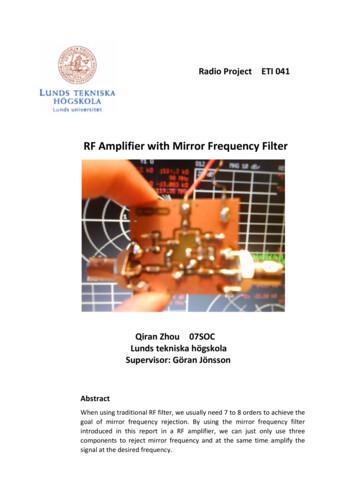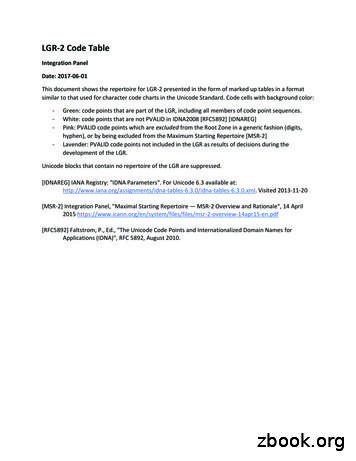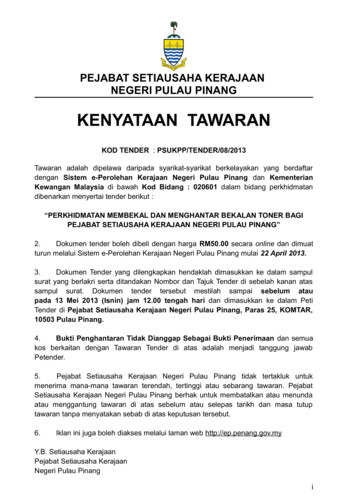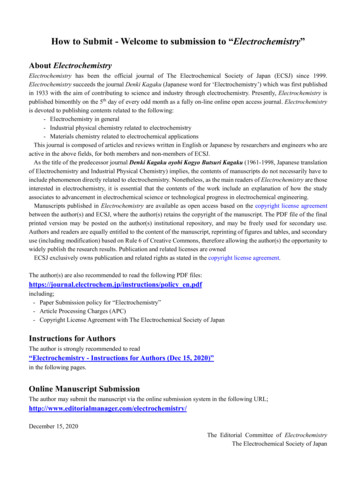Analysis Of Letter Frequency Distribution In The Voynich .
Analysis of Letter Frequency Distribution in theVoynich ManuscriptGrzegorz JaśkiewiczWarsaw University of TechnologyThe Faculty of Electronics and Information Technology,ul. Nowowiejska 15/19 00-665 Warsaw Polandgrzegorz@jaskiewi.czAbstract. The Voynich manuscript is one of the biggest mysteries inlinguistic science. Although a lot of researches are being made, the author, the origin and the content of the manuscript still remain unknown.In this work letter frequency distributions of about 300 languages werecompared to one of the language in the Voynich manuscript. The studyshows the most similar languages according to this characteristics of anatural language.Keywords: Letter frequency distribution, Voynich, statistics, linguistics, Wikipedia1IntroductionThe Voynich manuscript is a book handwritten on 240 vellum pages, rich inillustrations. The book has its name after the Polish-Lithuanian-American bookdealer - Wilfrid Michael Voynich, who acquired it in 1912. Despite many studieson the Voynich manuscript, the author, the content of the script and even thelanguage remains unknown. Handwritten letters in Voynich manuscript do notresemble any alphabet known to human (see figure 1).Fig. 1. Handwritten letters in Voynich manuscriptCONCURRENCY, SPECIFICATION AND PROGRAMMINGM. Szczuka et al. (eds.): Proceedings of the international workshop CS&P 2011September 28-30, Pułtusk, Poland, pp. 250-261
Analysis of Letter Frequency Distribution in the Voynich Manuscript251The research performed with the C14 dating on manuscript’s vellum showsthat the manuscript was created between 1404 and 1438. There are many hypothesis about the possible content of the Voynich manuscript. All of them canbe roughly divided into 3 categories [7].1. Ciphertext - the manuscript is ciphered with some cipher.2. Synthetic language - the manuscript is written in a synthetic language (likeEsperanto).3. Exotic natural language - the manuscript is written in a natural language inplain with an invented alphabet.In this study the third hypothesis is explicitly used. Text samples of manydifferent languages were compared to the Voynich manuscript in order to designate the languages which are the most similar to the language that is used inthe manuscript.The previous research on the language in the Voynich manuscript based on“exotic language” hypothesis, carried out by Zbigniew Banasik, suggested thatit may come from north-eastern Asia and is a plaintext written in the Manchulanguage [2]. The author of this study proposed a translation of several wordsinto English.Other research shows that the manuscript has a linguistic nature [6] [9]. Itconforms to the Zipf’s law [12].Dr. Leo Levitov’s analysis suggests that the Voynich manuscript may be aliturgical manual for the Cathar religion written in ciphertext [8] in order todeceive the Inquisition. However, this hypothesis has been strongly criticized.Dr. Jacques Guy, a linguist, suggested that the Voynich manuscript has got asimilar word structure to many language families of central and east Asia. Thoselanguages include Sino-Tibetan and Tai language family [4].In spite of a fact that the volume of the Voynich manuscript is relatively large,it doesn’t contain much text. Therefore it is impossible to use many algorithmsbased on statistics, data mining or artificial intelligence. Such algorithms wereused to extract information from documents were knowledge about a languagewas only partial e.g. a Sumerian cuneiform script. Simple algorithms that donot require much data, can be used to analyze the manuscript. In this worka statistical analysis of a letter frequency distribution was used to find similarlanguages to the one that was used in the Voynich manuscript.The research involving linguistic studies often compare an unknown languageto the well-known language by its structure and syntax. Such comparison isprecise, however it is limited by the knowledge of a researcher. In this work asimple characterization of language was used to compare many languages. Thisallowed to automate the whole process and to increase the scope of comparisonsat cost of accuracy of a single comparison.2Letter Frequency DistributionThe letter frequency distribution for a given text sample is a function whichassigns each letter a frequency of its occurrence in that the text sample. The
252G. Jaśkiewicztext sample D is a sequence of letters over alphabet Σ.D (li )n0 Σ ?The letter frequency distribution could be defined asfD (l) card(l0 : l0 D l0 l)card(D)A letter frequency distribution analysis has got various applications in differentdomains:– cryptanalysis - a letter frequency distribution is a tool used to break simpleciphers like substitution ciphers or transposition ciphers,– data compression - a study of a letter frequency distribution is also used inmodern data compression techniques e.g. the Huffman coding,– usability design - the Dvorak keyboard placement is based upon the letterfrequency distribution in English language,– computational linguistics - a distribution of pairs and triples of letters maybe used to automatically recognize a language of an unknown document.It is easy to observe that there are countably many symbols in all alphabetsall over the world. Therefore any letter frequency distribution has got a discretedomain and it could be described by a single sequence of real-valued numbers.Such sequences can form a Banach space with a well-defined distance function,depending on additional assumptions about analyzed sequences [10]. 1 is the space of sequences (an ) n 1 which satisfy the condition X ai i 1in this space, the distance is defined in following waydist(a, b) X ai bi i 1We could assume that any single language has the finite set of letters. Therefore the distribution for a single text sample in given language is zero almosteverywhere. The corresponding space of sequences is known as a00 space. It iseasy to check thata00 1(1)Therefore distance function from 1 space is still valid in a00 space. In thea00 space distance could be introduced in many other ways, however this is nota goal of this study and the knowledge of (1) is enough.
Analysis of Letter Frequency Distribution in the Voynich Manuscript3253Experiment Set-upThe goal of the experiment was to find the languages known to human that maybe similar to the language used in the Voynich manuscript. A large corpora oftexts in different languages was needed to conduct such experiment. This corporawas built upon random texts retrieved from the Wikipedia.The Wikipedia is an online encyclopedia containing knowledge on varioustopics. It has got a great number of human-made translations in nearly 300 languages including dead languages like Latin or Old Church Slavonic and artificiallanguages like Esperanto or Volapük. There are even non-official Wikipediaswritten in Klingon language by Star Trek fans - those were not considered, astheir structure differs significantly from regular Wikipedia.The amount of articles in various language versions of Wikipedia differs significantly. The biggest language version is an English one containing over 3.5mln of articles. The second language version of Wikipedia is German and thethird one is French. The Polish Wikipedia is relatively big - it’s on the fifth placein terms of article count with more then 800.000 of articles. The distribution ofWikipedias sizes has been shown on a figure 2. It can be clearly seen that language versions of Wikipedia having article count in range 100 - 10.000 representvast majority of language versions. Due to this fact the decision was made tosample each language version with 100 randomly selected articles and combinethem, in order to create single text sample for selected language.Fig. 2. A distribution of article count in different language versions of Wikipedia
254G. JaśkiewiczEach language version of Wikipedia utilizes the same underlying softwareframework to manage content. Wikipedean articles are presented to users in thesame fashion regardless of the language version. Even a structure of HTML pagehas got common elements for each version. It is very convenient to use this factduring creating a screen-scraper. Following assumptions about HTML structureof Wikipedean page were made:– Content of an articles is always in a HTML div with the same identifierregardless of the language version;– Each Wikipedia has a button for selecting a random article. This buttonresides in a HTML div with the same identifier regardless of language version.With those assumptions the screen-scraper was written in Java in order toretrieve random articles from each language version of Wikipedia. The HtmlUnitlibrary was used to mimic a human clicking on hyperlinks.While running a data retrieval procedure, it turned out that one small fraction of all considered Wikipedias failed to satisfy the assumptions. This fractionwas tiny (approx. 20 instances) and screen-scraper was modified to accommodate them. However, only one of Wikipedias has completely no Random Articlebutton. This version of Wikipedia was rejected.There are available to the public several transcriptions of the Voynich manuscriptinto the ASCII encoding. Those transcriptions differ slightly as it is not alwaysclear if some glyph is a new letter or a ligature. The transcription used in thisresearch is freely available on the Internet [3].4ExperimentsThe downloaded articles are not always entirely written in a desired language.They are usually contaminated by the English language. This phenomenon is alsovisible in the spoken language. After having all necessary data retrieved fromthe Wikipedia, the quality of the results was tested by sampling the text corporain a random language. Some languages that contained no latin characters wereselected for the evaluation, so any latin character was treated as undesired one.The ratio of the undesired characters to all text was presented in figure 3.It is possible that the languages, which have contact with the western culturecan assimilate more foreign words. The perfectly pure sample of any languagecould not be obtained from Wikipedia due to the culture assimilation process visible especially well on a worldwide communication medium like the Internet.Languages evolve throughout centuries and a character frequency distributionmay change. It would be perfect to have samples of all languages from the erawhen the Voynich manuscript has been written. However, for the sake of thisexperiment available samples have been used and an error have been estimatedby mean calculated on tested languages, which was 3%.A character frequency distribution should converge to some function as theamount of evaluated text tends to the infinity. However, the estimation of speedof this convergence is a big problem as a probabilities of occurrence particular
Analysis of Letter Frequency Distribution in the Voynich Manuscript255Fig. 3. Ratio of latin characters in sample to sample sizeletter on a particular position in any text are not independent. Therefore, thespeed of this convergence was checked empirically. The 1 measure (2) was usedto measure the distance between two distributions.Xd(f, g) f (x) g(x) (2)x UThe English language with letter frequency taken from [1] was chosen as abenchmark. To test the convergence of the letter frequencies, the consecutiveprefixes of a sample text were taken, the character frequency distribution wasevaluated on those prefixes and results were compared to benchmark by the 1 standard distance function. Three books were downloaded from the ProjectGutenberg site to conduct this test. These books were:– The Adventures of Sherlock Holmes written by Sir Arthur Conan Doyle– 20000 Leagues Under the Seas written by Jules Verne– Father Goriot written by Honore de Balzac (English translation)The result of this test is shown on figure 4. It can be clearly seen that thedistribution of letter frequencies is close to the benchmark. However, it is notexactly the same distribution - for a sample which is big enough there is adifference, which could be bounded by 5% under the 1 norm. We will assumethat this error margin will hold for data retrieved from the Wikipedia.
256G. JaśkiewiczFig. 4. The difference in letter frequency distribution between the benchmark and asampleThe measure 1 itself does not work well when it comes to comparing twodifferent languages, because both can have different charsets. It may even happenthat two text samples in the same language can have different charsets, e.g. textsin Serbian language can appear in a latin alphabet as well as in cyrillic one.An alphabet in the Voynich manuscript is completely different from any knowncharset, so such approach would have failed completely. In order to accommodatethis issue, the different measure was definedd(f, g) Xai · f (σf (i)) g(σg (i)) (3)i 1where σf is such injective assignment σf : N Dom(f ) which satisfiesf (σf (k)) f (σf (k 1))This assignment is well defined as card(Dom(f )) ℵ0 . In equation (3) a suppressing factor a (0, 1) was introduced to reduce the error caused by the differences in size of two different charsets and occurrence of letters from differentcharsets. It is easy to check that (3) is a still valid distance function.Before advancing to the final experiment, the test of measure (3) was made. 23samples of different languages where compared all to all using (3) measure. Eachcomparison resulted in a single number describing similarity of two languagesamples. Lower number means more similar letter frequency distributions. Zerovalue means the exact match of two distributions. The results of those tests areshown in figure 5.
Analysis of Letter Frequency Distribution in the Voynich Manuscript257Fig. 5. Similarity of languages based on letter frequencyWe can see that two languages, which are rich in vowels (e.g. French, Spanish), tend to have a lower (3) distance than two languages poor in vowels (e.g.Serbian, Czech). Languages from the same language family (e.g. Slavic) tend tohave a lower distance. Unfortunately, it is not the rule - sometimes completelydifferent languages are similar in measure (3).5ConclusionThe final test was carried out to compare the transcription of the Voynichmanuscript to each text sample in different language using the measure (3).The top five matches are:–––––MoldavianKarakalpakKabardian CircassianKannadaThaiThe regions, where those languages exist, are marked on figure 6.The first three results designate Caucasus region and other two the region ofwest Asia. The second match would explain similarity of the Voynich manuscriptto Sanskrit and hypothesis stating that it has got its origin in far Asia. Both
258G. JaśkiewiczFig. 6. Regions indicated by character distribution similarityAsian matches designate the region near China, historically influenced by thiscountry. Hypothesis stating that the Voynich manuscript may have Chinese rootswould designate the same region. Also the fact that figures in manuscript arenot typical for China could be explained - it could be created not in China, butnearby - in the region influenced by China, like Indochina region. Similarity toThai language was also proposed by dr. Jaques Guy.Those two matches are not distant in a world scale - it is possible thatthe manuscript may have been created somewhere between those regions. Thedata used for the purpose of this research depicts only the current state of thelanguages and it captures only the official status of a language - neither minordialects nor historical language evolution are taken into consideration, so moreprecise region cannot be indicated.Based on considerations from the section 3 a total difference between a letterfrequency distribution for a given language and a letter frequency distributioncalculated on text sample could be bounded by 8%. Therefore, difference betweena letter frequency distribution of text sample and a letter frequency distributionof the language in Voynich manuscript could be bounded by 13% in 1 norm.To estimate this error under (3), some assumptions must be made how twodistributions differs. In this study an assumption was made that each letter contributes the same value to overall error, which could be calculated by summinga geometric sequence.e b1 c(card(Dom(fvoy )))·card(Dom(fvoy ))1 c(4)
Analysis of Letter Frequency Distribution in the Voynich Manuscript259where b is estimated error bound, c is suppressing factor equal 0, 96 and fvoyis a letter frequency distribution calculated for the Voynich manuscript. Thetranscription used in this study contains 26 glyphs, socard(Dom(fvoy )) 26ande 0, 4%With such error estimate a list of possible languages reaches about 40. Themost prominent matches indicate Asia, the other ones from the list indicate thelanguages existing in Europe.Similarity to both language families could be just coincidence, but there isa theory that the Voynich manuscript was created by a traveller visiting China,who didn’t know the Chinese language and alphabet [11]. Such traveller may havewritten down information that he learned in this region in invented alphabet.The traveller might have been European, as the manuscript was later discoveredin Europe. Similarity to both Asian and European language fits this theory well.If an author of the manuscript was European, his language habits may haveinfluenced a letter frequency distribution in the manuscript, resulting in somesimilarity to the author’s native language.The second conclusion drawn from this research would be the fact that language in the Voynich manuscript may be the language poor in vowels. When theletter frequency distribution from the manuscript is compared to the distributions of other languages, it behaves similarly to the languages poor in vowels.The observed values are significantly higher than those obtained by comparinga language rich in vowels.To observe this fact the language from the manuscript was compared tolanguages rich in vowels - Swedish and French as well as languages poor invowels - Serbian and Moldavian. Each comparison was carried out by comparinga letter frequency distribution of the selected language to distributions of all ofthe languages. In figure 7 there are shown cumulative histograms of obtainedvalues for each language. Histogram for language from the Voynich manuscriptis similar to histograms for languages poor in vowels.This result acknowledges the outcome obtained by Jacques Guy using theSukhotin algorithm [5] for vowel identification, where only 4 vowels were identified.6Future WorksWith the list of languages similar to the Voynich manuscript it is worth to analyzedeeper languages which are the most similar to language in the manuscript.Bigger and better text samples of selected languages could be obtained andmore complex algorithms could be used to analyze and compare them.Results of this study indicate that the language from the Voynich manuscriptis based on Asian language - it is also possible that it was somehow influenced
260G. JaśkiewiczFig. 7. Histograms of comparisons for all languagesby European languages. It still leaves many possibilities to consider, but withconjunction with historical research this area of speculations could be narrowed.7AcknowledgementsWe would like to thank my mentor prof. Jaroslaw Arabas for advices providedwhile writing this article.References1. Beker, Henry; Piper, Fred, Cipher Systems: The Protection of Communications,Wiley-Interscience, p. 397, 19822. Zbigniew Banasik, Jorge Stolfi, Zbigniew Banasik’s Manchu theory,http://www.ic.unicamp.br/ stolfi/voynich/04-05-20-manchu-theo, 20043. Voynich Manuscript ions/Voynich-101/index.html4. Jacques Guy, Statistical Properties of Two Folios of the Voynich Manuscript, Cryptologia, XV, number 4, pp. 207-218, July, 1991.5. Jacques Guy, Vowel identification: an old (but good) algorithm, Cryptologia, XV,number 3, 19916. Gabriel Landini, Evidence of linguistic structure in the Voynich Manuscript usingspectral analysis, Cryptologia, 2001
Analysis of Letter Frequency Distribution in the Voynich Manuscript2617. Landini, Gabriel, A Well-kept Secret of Mediaeval Science: the Voynich manuscript,Journal of the University of Birmigham Medical and Dental Graduates Society,19988. Leo Levitov, Solution of the Voynich Manuscript: A Liturgical Manual for theEndura Rite of the Cathari Heresy, the Cult of Isis, Aegean Park Press, 19879. Sravana Reddy, Kevin Knight, What We Know About The Voynich Manuscript,The Natural Language Group at the USC Information Sciences Institute10. Walter Rudin, Functional Analysis, PWN, 200911. Voynich Manuscript mailing list 256.html12. Zipf G. K, The Psycho-biology of Language, Hought Mifflin Co, Boston, pp. 20-48,1935
The Voynich manuscript is a book handwritten on 240 vellum pages, rich in illustrations. The book has its name after the Polish-Lithuanian-American book dealer - Wilfrid Michael Voynich, who acquired it in 1912. Despite many studies on the Voynich manuscript, the author, the con
Letter 1 Letter 2 Letter 3 Letter 4 . Letter 5 Letter 6 Letter 7 Letter 8 Letter 9 Letter 10 Letter 11 Letter 12 Letter 13 Letter 14 Letter 15 Letter 16 Letter 17 . the intellect for the attainment of the divine union of love. Proofs from passages and figures of Sacred Scripture. Chapter 10: A division of all apprehensions and ideas
Resumes for Computerized Resume Searches 6 Section Headings 7 . Online Applications 13 Cover Letters: 14 Cover Letter Refresher Course 15 General Outline for a Cover Letter 17 Sample Cover Letter 18 Additional Sample Letters: 19 Prospecting Letter Networking Letter Thank-you Letter Acceptance Letter Withdrawal Letter Rejection Letter .
113 70 0645 arabic letter meem 114 71 06ba arabic letter dotless noon 115 72 0646 arabic letter noon 116 73 0648 arabic letter waw 117 74 0624 arabic letter hamzah on waw . 121 78 0649 arabic letter alef maqsurah 122 79 06d2 arabic letter ya barree 123 7a 06be arabic letter knotted ha 124 7b a
2 Mirror Frequency Filter 2.1 Mirror Frequency In radio reception using heterodyning in the tuning process, the mirror frequency is an undesired input frequency that is capable of producing the same intermediate frequency (IF) that the desired input frequency produces. It is a potential source of interference to proper reception.
Length of leaf (cm) 9.5–14.5 14.5–19.5 19.5–24.5 24.5–29.5 Frequency 3 8 12 7 12 10 8 6 4 2 0 9.5 14.5 19.5 24.5 29.5 Length of leaf Frequency FREQUENCY POLYGONS A frequency distribution may be displayed as a frequency polygon. A frequency polygon may be superimposed on a histogra
letter. If the administrator does not feel you are a good fit after reading your cover letter, your résumé likely will not get a first look. Without a stellar cover letter (letter of introduction), you might never receive a call or email. Just remember: The purpose of a cover letter is to get your résumé read.
*George Washington Carver had a strong faith in God. Photo 1 Photo 2 Letter 1 Letter 2 Letter 3 Letter 4 *George Washington Carver was resourceful and did not waste. Photo 1 Photo 2 Photo 3 Letter 1 Letter 2 Letter 3 *George Washington Carver was a Humanitarian. Photo 1 Photo 2 Photo 3 Photo 4
0644 arabic letter lam 0645 arabic letter meem 0646 arabic letter noon 0647 arabic letter heh 0648 arabic letter waw 0649 arabic letter alef maksura 064a arabic letter yeh tashkil from iso 8859























